December 30 -After the partitioning of Bengal the
previous
year, The All India Muslim League (Urdu: مسلم لیگ ) is founded
at
Dhaka, by the young Aga Khan ( Sir Muhammed Shah سر محمد
شاه)
to
safeguard the rights of Muslims in predominantly Hindu India. In
Pakistan, the League later formed the first government, but fell
apart in
the 1950s following an army coup. In Bangladesh, the party after
a brief
resuscitation became insignificant.
Back to TOP
Other events of 1906-1907
- Earthquakes occur in Colombia; in Taiwan (Formosa);
and in Santíago, Chile a huge one levels the city.
- Gustav Mahler's Symphony No. 6 (3rd revision) performed at
Essen.
- Explorer and mountaineer Luigi, duc d'Abruzzi , son of the
'House of Savoy' becomes the first European to scale the
highest
peaks in East Africa's Ruwenzori Range.
Henry Morton Stanley was the first westerner to sight the
Ruwenzori in 1889, but the Duke of Abruzzi climbed
sixteen
summits in the range, including six of the highest peaks, one of which
bears his
name, Mount Luigi di Savoia.
In 1897 he made the first ascent of Mount Saint Elias (North
America,
5,489 m). Before the Ruwenzori expedition, he lost two fingers
from
frostbite during an attempt to reach the North Pole. He was the
son of a
Spanish King and the nephew of an Italian monarch, and died on March
18, 1933,
at Ghiohàr, near Mogadishu in Somalia , where
he
had founded a village to experiment new forms of cultivation.
- U. S. Food and Drugs Act ("Wiley Act") 1906 . Legislation
was
passed in June, to be enforced from the following year. In 1883 Dr. Harvey W.
Wiley,
was appointed to succeed Peter Collier as head of the Division
of
Chemistry in Washington. He used popular journalism to mount a
crusade for regulation of food and drug items, the call for the adulteration
of food
to be legislated as a crime having been made first by his predecessor. It
resulted in the act of 1906 for "preventing the manufacture, sale, or
transportation of adulterated or misbranded or poisonous or deleterious
foods,
drugs, medicines, and liquors, and for regulating traffic therein, and for
other
purposes." He even got together a voluntary "poison squad" of young
subjects who were willing to eat only foods containing known quantities of
chemical preservatives, to see if they came to any harm from these
substances.
Now, the Food and Drugs Administration, after a chequered
career,
comes under the Department of Health and Human
Services.
- Willem Einthoven, born in Java in 1860, having
gained
medical qualifications at Utrecht, the Netherlands, and
experience in a few medical specialities, and in electro-physiology,
publishes
"The Telecardiogram", demonstrating the conformity and
reproducibility
of the electrical wave-form of the human heart, and its diagnostic
applications in
heart disease.
- The veterinarian and immunologist, Camille Guérin,
establishes the
basis of the immunity to tuberculosis as a response to live bacilli in the
blood
and investigates the effect of attenuated strains, as Pasteur
before him,
injecting bovine bacilli into animals.
- Sir Joseph John Thomson, OM, FRS (1856-1940).
In 1884 he became Cavendish
Professor of Physics, at Cambridge. He is awarded the
Nobel
Prize in Physics for his discoveries in 1897 of a particle, called a
'corpuscle'
by J.J.Thomson, with a mass much smaller than the smallest
previously
recognised, the hydrogen atom, but carrying an equal, though opposite,
charge.
The particle,
" appears to form a part of all kinds of matter under the
most
diverse conditions; it seems natural therefore to regard it as one of the
bricks of
which atoms are built up," and thus, "the atom is not the ultimate limit
to the
subdivision of matter; we may go further and get to the corpuscle, and at
this
stage the corpuscle is the same from whatever source it may be
derived."
This conclusion highlights the universal significance of the corpuscle, or
electron. The instrument used by him was the cathode ray tube, refined by
depleting it of
gas, since he believed that earlier experiments in attempting to
electrically
deflect the ray of negative particles in such a tube had met with failure
because
of its interfering ionising effect on the negative stream. For determination
of the
charge he used the principle of using conditions of controlled saturation
to form
water droplet condensation around charge particles. A later refinement
allowed
the charge on them to be measured by using an opposing electrical
charge so
that when " the upward force on each drop is equal to the
weight of the drop, the drops will not fall at all, but will, like Mahomet’s
coffin, remain suspended between heaven and earth.". I am uncertain
about his
source for the suspension oh the Prophet's coffin, but his theories were
totally justified, and he succeeded in determining by means of these
apparatuses,
the mass, m, as equal to 6 x 10-28 grammes, or only about
1/1,700
of that of the hydrogen atom, and the charge as 3.0 x 10-10
electrostatic units, or 10-20 electromagnetic units, the same
as that
of a hydrogen atom.
Back to TOP
- Nobel Prize in Medicine conferred jointly to :
Camillo Golgi,( 1843-1946), Italian physician and histologist, who
worked
and lived in Pavia, and Santiago Ramón y Cajal (1852-1934), who was born in
Chile,
graduated at Zaragoza, and studied and did his research in
medicine at
Madrid. The prize was the fruit of their laboriously fine work on the
specific staining of neurons, a cell defined a decade or so earlier by
German
anatomist Wilhelm von Waldeyer-Hartz. Golgi, who
gave his
name to several histological entities, using sodium chromate in 'la
reazione
nera', showed nervous system cells as discrete with processes. The
same
reaction, in a slightly modified form was used to greater effect by
Ramón y
Cajal. At the time of the bestowal of the prize, they appeared to be in
contention with each other, with Golgi opposing the theory of an
independent 'neuron' in the sense of it being embryologically
pre-determined,
and as a physiological cellular entity, favouring a 'rete nervosa diffusa'
although
he was the first to demonstrate protoplasmic processes and dendrites on
neuronal cells. Ramón y Cajal, meanwhile, embraced the
anatomical
integrity of individual neurones, the idea of flow across neurons being
dynamically polarised and that the "nervous movement in these
prolongations is towards the cell or axon, while it is away from the cell in
the
axons." He also observed the ability of axons to regenerate without
the
presence of Schwann cells, of neurofibrils, and his detailed
descriptions
of terminal 'boutons' led to a whole new area of development in the form
of
synaptic physiology. Golgi saw in this view an argument in
favour of
localisation of brain function, whereas his own detailed investigation of the
hippocamus, a specialised area of the brain, as rather indicating a
neuronal
network functioning as an 'organ'. He argued; "While denying the
existence of
finely demarcated central zones depicting the exclusive seat of the
central
distribution of nerve fibres, we feel that we can accept, however, the
existence of
territories to which most of the fibres are directly
distributed."
Later
developments, especially the neurone seen by means of the electron
microscope, favoured Cajal's interpretation. Nevertheless,
Golgi has found support in many recent descriptions of 'electrical
synapses', first described in crayfish in the 1950's.
- Mikhail Semionovich Tsvett (1872-1919), Russian botanist
working
at the Institute of Plant Physiology in Warsaw, Poland,
successfully
separated plant pigments -chlorophylls, xanthophylls, and carotenoids-
by noting
their differential solubility in alcohol, ether, and aliphatic or benzene
solvents, and
further separating them by means of passage through a column of
adsorbing materials, a process he calls chromatography.
- The U.S. population reaches 85 million, Britain has
38.9
million, Ireland 4.3 million, France 39.2 million,
Germany
62 million, and Russia over 120 million. China's
population
approaches 400 million, and India's population nears 300 million.
- Henri Moissan (1852–1907) dies suddenly in Paris
in
February 1907, shortly after his return from receiving the Nobel Prize in
Chemistry for his work in isolating fluorine from its compounds.
- Nettie Maria Stevens at Bryn Mawr, Pennsylvania,
(1861-1912), an American cytologist, publishes a monograph in which she
identifies the X and Y chromosomes, and their determination of the
gender of an
embryo.
- Giosuè Carducci is crowned with the Nobel Prize in
Literature -
(Valdicastello, 1835 - Bologna, 1907). A famous, and the first Italian poet to
receive
the prize, like Moissan, the winner of the chemistry prize, he died in the
following
year. Most of his poems are too allusive for the modern ear, but below,
entitled 'In una villa' is a short
one to indicate his style.
|
Fires after the San Francisco
earthquake :

Ruwenzori mountains :

The Duke of Abruzzi expedition in Africa :

Ruwenzori peak of Mt. Stanley :
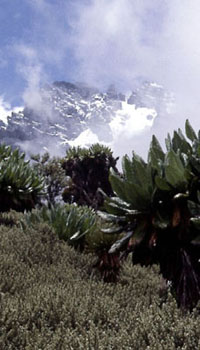
Late 19th. century magnetic anti-headache cap :
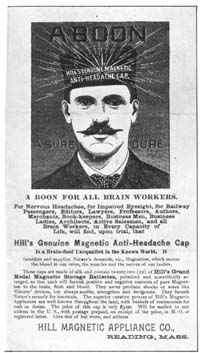
Koch's cholera vaccine,
not available quickly
enough,
provoked this cartoon from
LIFE
rebuking "Science," for inaction :
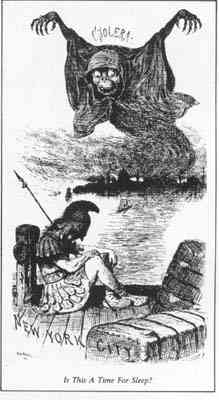
J.J. Thomson's Cathode ray tube :
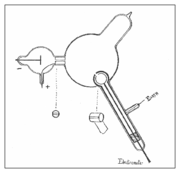
Ramon y Cajal :Camillo Golgi :
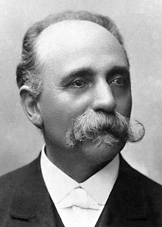 
Hippocampal formation prepared by Golgi :
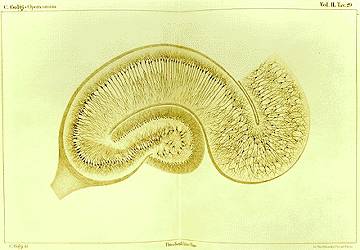
Retinal tissue as prepared by Cajal :
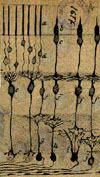 
|
Back to TOP
|
'In una villa'
O tra i placidi clivi, tra i cedri e le palme sedente
bella Arenzano al riso de la ligure piaggia;
operosa vecchiezza t'illustra, serena t'adorna
signoril grazia e il dolce di giovinezza lume;
facil corre in te l'ora tra liete aspettanze e ricordi
calmi, sí come l'aura tra la collina e il mare.
Giosuè Carducci
|
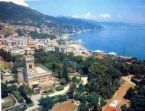
|
In a villa
Oh, between the placid slopes
between the cedars
and the motionless palms
lovely Arenzano,
laughter of the Ligurian shore;
ancient works
depict you,
serenely, adorns you
refined grace
and the sweetness
of lit up youth;
the hours pass by in you
easily, in happy
expectation
and tranquil
recollection,
just like the breeze blowing
between the hill and the sea.
My translation (!!)
|
Back to TOP
The visual arts
|
The artists represented below were concerned with very different
ideas in
relation to their contemporaries in France, where the bright
colours and
thin palette of the Fauves, as exemplified in the stylised body
figures of
Matisse, ran alongside the earliest trends towards
Cubism,
shown in this earlier painting by Braque of a region repainted
many
times by their much admired Cézanne.
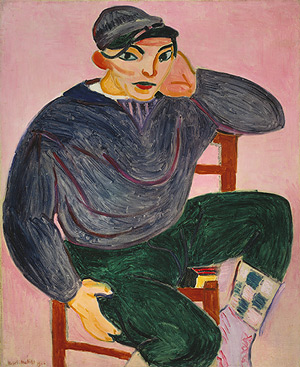
The German, Nolde, the Belgian, Ensor, and the
Norwegian,
Munch, were much more expressive in their use of colour and
brush, a
quality they shared with the school of German Expressionism, and their
paintings,
resembling Van Gogh in their intensity of feeling and emotion, are
characterised by an almost violent or gruesome caricature of masks and
figures,
which bring to mind old German masters and English satirists. Although
Ensor's
main work was earlier, its controversial subject matter did not reach any
significant audience until well into the beginning of the 20th century. Even
in the
views of landscape, they seem to convey a deep and profound unease,
working
into their pictures a psychological fervour which is quite the different to the
rather
analytic approach pursued by Picasso and Braque in
cubism,
or Matisse in his unique idiom.
|
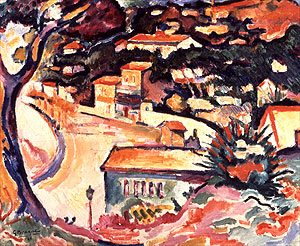


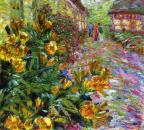

- Top:G.Braque :L'Estaque.1906
- Middle row :E. Munch Vier Mädchen auf der Brücke, 1905
- J. EnsorSelf-portrait on a Belgian stamp.
- Bottom row :E. Nolde Yellow Flowering Shrub, 1906
- E Munch Winterlandscape, Elgersburg, 1906
- Left, bottom:H. Matisse : The Young Sailor II, 1906
|
Back to TOP
Poetry Link:In Tenebris -
I
( In 1903 the title was "De Profundis.")
"Percussus sum sicut foenum, et aruit cor meum." - Ps. ci
["My heart is smitten and withered like grass" - Psalm 102:5]
Wintertime nighs;
But my bereavement-pain
It cannot bring again:
Twice no one dies.
Flower-petals flee;
But, since it once hath been,
No more that severing scene
Can harrow me.
Birds faint in dread:
I shall not lose old strength
In the lone frost's black length:
Strength long since fled!
Leaves freeze to dun;
But friends can not turn cold
This season as of old
For him with none.
Tempests may scath;
But love can not make smart
Again this year his heart
Who no heart hath.
Black is night's cope;
But death will not appal
One who, past doubtings all,
Waits in unhope.
Thomas Hardy (1840-1928)
For all of the poems by Thomas Hardy go to:
Thomas Hardy
Back to TOP
Full Page Index
Back to Mundus2 Part1
For text of original historical documents related to this site visit  H
ATI
ZA KALE NA ZA
LEO
H
ATI
ZA KALE NA ZA
LEO
Email!
| © M. E. Kudrati,
2006:This document may be
reproduced and redistributed, but only in its entirety and with full
acknowledgement of its source and
authorship
|


















 H
ATI
ZA KALE NA ZA
LEO
H
ATI
ZA KALE NA ZA
LEO